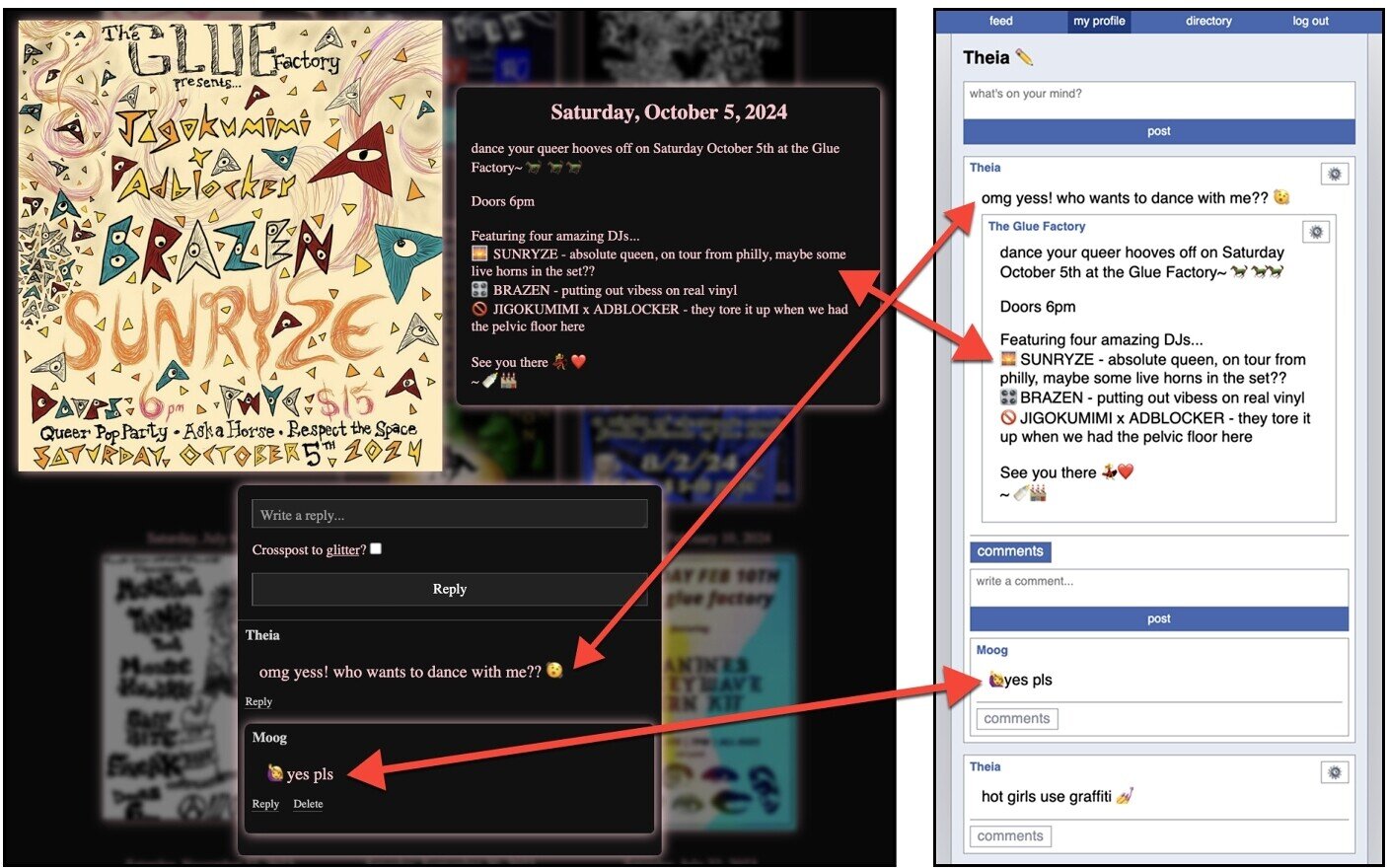Tech
Graffiti framework lets people personalize online social spaces while staying connected with others

Say a local concert venue wants to engage its community by giving social media followers an easy way to share and comment on new music from emerging artists. Rather than working within the constraints of existing social platforms, the venue might want to create its own social app with the functionality that would be best for its community. But building a new social app from scratch involves many complicated programming steps, and even if the venue can create a customized app, the organization’s followers may be unwilling to join the new platform because it could mean leaving their connections and data behind.
Now, researchers from MIT have launched a framework called Graffiti that makes building personalized social applications easier, while allowing users to migrate between multiple applications without losing their friends or data.
“We want to empower people to have control over their own designs rather than having them dictated from the top down,” says electrical engineering and computer science graduate student Theia Henderson.
Henderson and her colleagues designed Graffiti with a flexible structure so individuals have the freedom to create a variety of customized applications, from messenger apps like WhatsApp to microblogging platforms like X to location-based social networking sites like Nextdoor, all using only front-end development tools like HTML.
The protocol ensures all applications can interoperate, so content posted on one application can appear on any other application, even those with disparate designs or functionality. Importantly, Graffiti users retain control of their data, which is stored on a decentralized infrastructure rather than being held by a specific application.
While the pros and cons of implementing Graffiti at scale remain to be fully explored, the researchers hope this new approach can someday lead to healthier online interactions.
“We’ve shown that you can have a rich social ecosystem where everyone owns their own data and can use whatever applications they want to interact with whoever they want in whatever way they want. And they can have their own experiences without losing connection with the people they want to stay connected with,” says David Karger, professor of EECS and a member of the Computer Science and Artificial Intelligence Laboratory (CSAIL).
Henderson, the lead author, and Karger are joined by MIT Research Scientist David D. Clark on a paper about Graffiti, which will be presented at the ACM Symposium on User Interface Software and Technology.
Personalized, integrated applications
With Graffiti, the researchers had two main goals: to lower the barrier to creating personalized social applications and to enable those personalized applications to interoperate without requiring permission from developers.
To make the design process easier, they built a collective back-end infrastructure that all applications access to store and share content. This means developers don’t need to write any complex server code. Instead, designing a Graffiti application is more like making a website using popular tools like Vue.
Developers can also easily introduce new features and new types of content, giving them more freedom and fostering creativity.
“Graffiti is so straightforward that we used it as the infrastructure for the intro to web design class I teach, and students were able to write the front-end very easily to come up with all sorts of applications,” Karger says.
The open, interoperable nature of Graffiti means no one entity has the power to set a moderation policy for the entire platform. Instead, multiple competing and contradictory moderation services can operate, and people can choose the ones they like.
Graffiti uses the idea of “total reification,” where every action taken in Graffiti, such as liking, sharing, or blocking a post, is represented and stored as its own piece of data. A user can configure their social application to interpret or ignore those data using its own rules.
For instance, if an application is designed so a certain user is a moderator, posts blocked by that user won’t appear in the application. But for an application with different rules where that person isn’t considered a moderator, other users might just see a warning or no flag at all.
“Theia’s system lets each person pick their own moderators, avoiding the one-sized-fits-all approach to moderation taken by the major social platforms,” Karger says.
But at the same time, having no central moderator means there is no one to remove content from the platform that might be offensive or illegal.
“We need to do more research to understand if that is going to provide real, damaging consequences or if the kind of personal moderation we created can provide the protections people need,” he adds.
Empowering social media users
The researchers also had to overcome a problem known as context collapse, which conflicts with their goal of interoperation.
For instance, context collapse would occur if a person’s Tinder profile appeared on LinkedIn, or if a post intended for one group, like close friends, would create conflict with another group, such as family members. Context collapse can lead to anxiety and have social repercussions for the user and their different communities.
“We realize that interoperability can sometimes be a bad thing. People have boundaries between different social contexts, and we didn’t want to violate those,” Henderson says.
To avoid context collapse, the researchers designed Graffiti so all content is organized into distinct channels. Channels are flexible and can represent a variety of contexts, such as people, applications, locations, etc.
If a user’s post appears in an application channel but not their personal channel, others using that application will see the post, but those who only follow this user will not.
“Individuals should have the power to choose the audience for whatever they want to say,” Karger adds.
The researchers created multiple Graffiti applications to showcase personalization and interoperability, including a community-specific application for a local concert venue, a text-centric microblogging platform patterned off X, a Wikipedia-like application that enables collective editing, and a real-time messaging app with multiple moderation schemes patterned off WhatsApp and Slack.
“It also leaves room to create so many social applications people haven’t thought of yet. I’m really excited to see what people come up with when they are given full creative freedom,” Henderson says.
In the future, she and her colleagues want to explore additional social applications they could build with Graffiti. They also intend to incorporate tools like graphical editors to simplify the design process. In addition, they want to strengthen Graffiti’s security and privacy.
And while there is still a long way to go before Graffiti could be implemented at scale, the researchers are currently running a user study as they explore the potential positive and negative impacts the system could have on the social media landscape.
More information:
Theia Henderson et al, Graffiti: Enabling an Ecosystem of Personalized and Interoperable Social Applications, Proceedings of the 38th Annual ACM Symposium on User Interface Software and Technology (2025). DOI: 10.1145/3746059.3747627
This story is republished courtesy of MIT News (web.mit.edu/newsoffice/), a popular site that covers news about MIT research, innovation and teaching.
Citation:
Graffiti framework lets people personalize online social spaces while staying connected with others (2025, October 1)
retrieved 1 October 2025
from https://techxplore.com/news/2025-10-graffiti-framework-people-personalize-online.html
This document is subject to copyright. Apart from any fair dealing for the purpose of private study or research, no
part may be reproduced without the written permission. The content is provided for information purposes only.
Tech
Europe tackles e-waste with eco-friendly innovation that helps reuse and repair

Researchers are developing reusable and environmentally friendly electronics for the health care, consumer and manufacturing sectors, replacing scarce materials with circular alternatives to build a sustainable future.
Europe’s appetite for electronics keeps growing, but so does the waste. From smartphones and laptops to medical sensors, more devices mean mounting piles of discarded hardware.
According to Eurostat, around 5 million metric tons of electronic waste is collected for recycling in the EU each year. That is more than 11 kilograms per household, enough to cover around 2,000 football pitches stacked a meter high.
These 5 million metric tons represent less than 40% of the total mass of electronics put on the European market annually. The rest often ends up in landfills because mixed materials make recycling difficult.
Smarter design
To tackle this challenge, the SUSTRONICS initiative is rethinking how electronics are made, from the materials used to the way products are assembled and repaired. Led by Dutch technology company Philips, it brings together 46 partners from 11 countries. The three-year initiative runs until May 2026.
“The SUSTRONICS researchers focus mainly on fundamental research into new solutions,” explained Ramon Caanen, who leads a sustainability consulting team at Philips.
This includes the use of bio-based, paper-based and more widely available materials, the sustainable manufacturing of electronic components as well as designs that enable better recycling.
The researchers’ goal is to embed sustainability into design, production and functionality, so that products can be better reused and more easily recycled.
That focus has gained urgency since the EU introduced new regulations on eco-design and the right to repair in 2024. They are meant to extend product lifespans, improve energy efficiency and make repairs simpler. They also aim to reduce environmental impact and promote a more circular economy with less waste.
Health care pilots
Health care is one of SUSTRONICS’s main proving grounds. While connected medical devices can improve patient care, their single-use electronic parts add to the e-waste problem. Three pilot studies are developing sustainable electronics for health care.
At Swedish hygiene company Essity Hygiene and Health, a partner in the global research, principal scientist Shabira Abbas is working on a smart incontinence pad designed to make life easier for both patients and staff.
The device is known as a change indicator and alerts staff when a pad needs replacing. A small clip-on reader sits outside the pad, is cleaned between patients, and is reused with each new pad.
“It is designed to improve both skin health and dignity,” said Abbas.
A removable electronic strip inside the pad measures temperature, humidity and enzymes. It can be recycled separately where facilities allow. The team uses paper substrates and 3D-printed metal-oxide sensors to reduce the use of material.
The pad also requires a small reader, which sits outside the pad, to transmit data to staff. This clip-on reader can be reused with each new pad.
“In between patients, you have to clean the reader, but otherwise they are reusable,” said Abbas. Her team’s challenge is making the connector foolproof and easy for staff to attach and remove.
They are also working on energy efficiency, adapting software to use minimal power while processing pad data. This is vital for medical devices that must run continuously, since the combined energy demand of many units greatly increases their overall carbon footprint.
The other two pilot devices include a skin patch for tracking glucose metabolism and a smart dressing for wounds, which signals when it needs replacing. In today’s medical practice, both are still single-use, so sustainability is a key challenge.
Better materials
The SUSTRONICS team is also exploring ways to improve production efficiency and use recyclable or environmentally friendly materials whenever possible. Part of the solution is moving to more common resources from those that are scarce and environmentally harmful, such as silver.
“Silver has a high upstream footprint. Replacing silver with more common materials such as copper or carbon can lower impact significantly. But the key challenge is to make these substitutes perform well in their intended electronics application,” said Caanen.
Beyond medical devices, pilots also target repairability in shavers and lighting, easier dismantling for recycling, and lower energy use.
Looking ahead
Their work ties in with wider EU goals. A new Circular Economy Act, expected in 2026, will create a stronger market for recycled materials, boosting both supply and demand across Europe. It supports the EU’s ambition to lead the world in circular economy practices by 2030.
Today, only about 12% of Europe’s materials are reused or recycled. The target is to double this to 24% by 2030 under the EU’s Clean Industrial Deal.
Caanen hopes that SUSTRONICS will become a flagship project for sustainable electronics, by demonstrating how the European electronics industry can benefit from sustainable, alternative materials for electronic components, while maintaining competitiveness.
For hospital patients, innovations like the smart pad could mean greater comfort, dignity and quality of care, while also contributing to a more sustainable, circular economy.
By combining practical health care solutions with ambitious environmental goals, the SUSTRONICS team demonstrates how technological innovation can improve everyday lives and support Europe’s drive for sustainability.
In the long term, such efforts could transform both the electronics industry and health care, showing that small devices can have a big impact.
Citation:
Europe tackles e-waste with eco-friendly innovation that helps reuse and repair (2025, November 17)
retrieved 17 November 2025
from https://techxplore.com/news/2025-11-europe-tackles-eco-friendly-reuse.html
This document is subject to copyright. Apart from any fair dealing for the purpose of private study or research, no
part may be reproduced without the written permission. The content is provided for information purposes only.
Tech
WIRED Roundup: Fandom in Politics, Zuckerberg’s Illegal School, and Nepal’s Discord Revolution

Leah Feiger: Zoë, I am obsessed with this story. Before you continue, I think that it’s really important to say that Caroline, the lovely reporter of this story on your business desk, obtained 1,665 pages of documents about the dispute about Zuckerberg’s house. This story is canon now.
Zoë Schiffer: Caroline Haskins is a complete star. Our fact-checking team literally cried when I asked them. They were like, “Wait, sorry, how many documents are we looking through?” I was like, “Yes.”
Leah Feiger: Shout out to the WIRED research team.
Zoë Schiffer: Absolutely. The school, I think we just have to say, is named after one of the Zuckerberg family chickens. It’s called the Bicken Ben School.
Leah Feiger: I mean, hearing you say this, it’s, I know you’re being serious, but again.
Zoë Schiffer: So, the Crescent City neighborhood in Palo Alto, where the Zuckerbergs live, as you can imagine, is some of the best real estate in the entire country. It’s filled with these gorgeous homes, a ton of greenery. Mark Zuckerberg has been expanding his presence throughout the years in this ultra fancy neighborhood. The plot of land that the Zuckerbergs live on has expanded to include 11 previously separate properties. This is so funny and just such a nightmare. If you’re living on the street, you paid whatever, $5 million for your house, and suddenly all of your neighbors are Mark Zuckerberg.
Leah Feiger: Important to note that not all of them are connecting either. I don’t totally understand what that means. Do they walk through a neighbor’s porch to get to their horse’s pool? What does this entail?
Zoë Schiffer: We have more questions. We have to Google Earth this. I think there’s some holes in this story that we need to fill in. The expansion first became a concern for Mark Zuckerberg’s neighbors, back in 2016, due to fears that his purchases were driving up the market pretty dramatically. But then, about five years later, neighbors started noticing that a school appeared to be operating out of the Zuckerberg compound. So, this is illegal to do without a permit, at least under the area’s residential zoning code. And so, naturally, the neighbors started to alert the city. Caroline Haskins, the reporter on the story, obtained over a thousand documents, like you said, outlining the resulting fight between the neighbors and the city authorities, basically arguing that, it felt to them like the Zuckerbergs were getting special treatment.
Tech
Urban infrastructure renewal: Engineers develop sustainable technique for even backfill distribution in aging city sites

Many developed nations are facing the simultaneous aging of infrastructure built during periods of rapid economic growth. Japan has reached a critical turning point where numerous buildings and structures constructed in the post-war boom era now require demolition and renewal. The catalyst intensified dramatically after the 2011 Great East Japan Earthquake, which exposed vulnerabilities in structures failing to meet modern disaster prevention standards, leading to sharply increased demolition activity in urban areas.
When structures are demolished, the foundation piles must be removed and classified as industrial waste, yet conventional backfilling methods consistently produce an uneven distribution of material throughout the borehole depth. This technical limitation creates serious risks, including ground settlement, structural tilting of adjacent buildings, and misalignment of newly installed foundations. As a result, the critical backfilling process lacks scientific rigor and quality control mechanisms.
In a recent breakthrough, a team of researchers led by Professor Shinya Inazumi from Shibaura Institute of Technology, Japan, has developed a novel method that can ensure uniform backfilling throughout the entire borehole depth, addressing both immediate safety concerns and long-term infrastructure sustainability. Their innovative findings were published in the journal Cleaner Engineering and Technology.
The proposed circulating mixing method was validated through model tests, field experiments, and advanced numerical simulations using the moving particle semi-implicit (MPS) method within a computer-aided engineering (CAE) framework. These tests demonstrated exceptional uniformity with a coefficient of variation of only 0.036, approximately ten times better than conventional soil improvement methods that typically range from 0.3 to 0.5. In addition, the field tests on 15-meter-deep boreholes confirmed that all samples exceeded the target strength of 1,500 kN/m² with no detection of structurally inadequate weak zones.
“Most significantly, our approach allows engineers to optimize process parameters and improve quality control by employing advanced MPS-CAE computer simulations to predict mixing behavior before construction. Moreover, it addresses Japan’s urgent infrastructure renewal needs while promoting sustainability by preventing soil degradation, reducing construction waste, and minimizing the carbon footprint of urban projects,” says Prof. Inazumi.
The findings reveal that this method is especially valuable when constructing high-rise buildings on sites with existing pile foundations, where improperly backfilled boreholes could compromise the stability of new structures worth millions of dollars. Notably, the proposed method prevents ground settlement and structural tilting that could lead to catastrophic failures during seismic events, addressing critical safety concerns in earthquake-prone regions.
“Our study establishes a new standard for geotechnical engineering in urban redevelopment with potential worldwide applications, particularly in cities facing aging infrastructure challenges. In densely populated metropolitan areas like Tokyo, New York, or London, where numerous buildings constructed during post-war economic boom periods now require demolition and reconstruction, this technology ensures safe and efficient site preparation,” says Prof. Inazumi.
The amalgamation of engineering techniques with numerical simulation in the proposed method enables the industry to shift from reactive quality assessment to proactive process optimization, improving the efficiency, safety, durability, and sustainability of urban redevelopment projects, especially in disaster-prone regions.
The paradigm shift in geotechnical engineering practice can help engineering consultancies and construction companies to reassure their clients of construction quality through pre-construction numerical analysis, enhancing transparency and accountability in urban infrastructure projects.
“Our innovative method supports sustainable urban development by minimizing construction waste and reducing the carbon footprint associated with material transportation and disposal. It further offers a pathway to improved geotechnical performance in urban infrastructure development, contributing to disaster resilience, protecting lives and property investments,” concludes Prof. Inazumi.
More information:
Shinya Inazumi et al, Sustainable approach to urban pile removal through evaluation of innovative circulating mixing for urban infrastructure renewal, Cleaner Engineering and Technology (2025). DOI: 10.1016/j.clet.2025.101103
Citation:
Urban infrastructure renewal: Engineers develop sustainable technique for even backfill distribution in aging city sites (2025, November 17)
retrieved 17 November 2025
from https://techxplore.com/news/2025-11-urban-infrastructure-renewal-sustainable-technique.html
This document is subject to copyright. Apart from any fair dealing for the purpose of private study or research, no
part may be reproduced without the written permission. The content is provided for information purposes only.
-

 Tech1 week ago
Tech1 week agoFrom waste to asset: Turning ethanol production CO₂ into jet fuel
-

 Tech3 days ago
Tech3 days agoNew carbon capture method uses water and pressure to remove CO₂ from emissions at half current costs
-

 Politics4 days ago
Politics4 days agoBritish-Pakistani honoured for transforming UK halal meat industry
-

 Sports2 days ago
Sports2 days agoTexas A&M officer scolds South Carolina wide receiver after touchdown; department speaks out
-
Sports1 week ago
College football winners and losers: The catch of the year saves Indiana
-

 Tech1 week ago
Tech1 week agoSecurity flaws in portable genetic sequencers risk leaking private DNA data
-

 Business1 week ago
Business1 week agoMore than 1,000 flights cancelled as US air traffic cuts enter second day
-

 Sports1 week ago
Sports1 week agoSteelers vs. Chargers (Nov 9, 2025) Live Score – ESPN


















